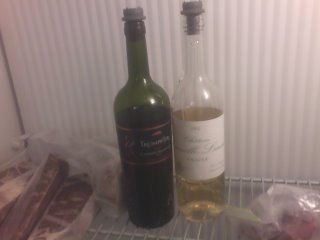Casanova di Neri Brunello di Montalcino 2001
Dark color with intense blackberry, chocolate and lightly toasted oak. Full-bodied and ultravelvety, with caressing tannins. Vanilla, chocolate and berry. Goes on for minutes. Best after 2010. 4,830 cases made.
Friday, November 17, 2006
Wednesday, November 15, 2006
Bin 22, Beaujolais Nouveau, and Other Stuff
This week is the annual unveiling of Beaujolais Nouveau. Thursday night I'll be at Wine Lover's on 2284 John Rolfe Parkway to taste Chris' selection in the weekly tasting. Come up and join us starting at 530 til about 7! I'm looking for those who attended the BIN 22 Italian Wine Tasting to use the COMMENT area below to tell us about the dinner last night. Jom Opalka is one of my current favorite distributors, and I'd love to hear about the event. We at the Fleming's Wine Spectator 90+ dinner enjoyed those pairings. Five distinct wines with the always eclectic foods that Fleming's rolls out for these dinners. By the way, use this link to track the countdown to the Wine Spectator Top 10 of this years Top 100 this week!
Sunday, November 05, 2006
Wine Chemistry 301

Ok, my estudiantes, this week let's get together and do a Chemistry experiment. We are going to freeze two opened bottles of wine and see if this is a "reasonable" way of saving wine over a long period of time, one which exceeds normal expectation. We know that oxygen is the enemy of opened wines, and that oxidation gives wine that vinegar taint over time. When we freeze wine, having first minimized the amount of air in the freezing vessel, we minimize the long term contact with oxygen in two ways: the vacuum itself minimizes some of it, and the solid nature of the ice keeps oxygen from permeating the wine. What we hope will happen is that the wine will, upon thawing, approximate a smaller diminution of flavor than if had been ruined by leaving in a liquid state. Join me in taking a partially consumed Red and White and let's freeze it for the next two weeks. Because of the properties of freezing, be sure to Vaccu Seal the bottle, or consider placing the wine in a plastic bag that has had most of the air removed. Leave some space for expansion though.
One thing we can expect is that in the process of freezing, the water in the wine will freeze prior to the alcohol. This, I'm told will allow some of the solids in the wine to "precipitate out", forming small crystal in the thawed wine. It is my understanding that these are tartaric acid crystals, and are tasteless. This will be the only flaw to the texture, but I'm told that the finished product can actually improve in taste because of the decrease in acidity! Well, we shall see! I take no responsibility for any broken bottles. Please Vaccu Seal the wine to preclude that!
When we are ready to thaw the wine...I'll have some techniques for that too, which even include the microwave! I think you will be amazed at the outcome.
The last thing that is important is to make notes about how the wine tastes before the freezing so we can compare. I have chosen a Argentine Cabernet Sauvignon, and a Bordeaux White, which is Semillon and Sauvignon Blanc. The latter is young and acidic, so we shall see if we lose too much character by losing the acid. The Cab is a typical South American with a light style and nice dark fruits. Very light tannins make this a candidate for storing in an unconventional way, because tannins would help to keep it from spoiling too quickly if left at room temperature.
See you in two weeks!
Friday, November 03, 2006
Hard At Work
Wednesday, November 01, 2006
Food/Wine Synergy
Lately, we have been concentrating on food and wine pairings at many of my haunts around town. Most of you have, by now, been introduced to my pairing with White Zinfandel, and the surprising result that it brings. We examine the intricacies of acid and salt in foods and how they affect wine. Further, oak in red wines affects spicy foods in surprising ways. We know that in the “old world”, wine is generally made in a style which will compliment food, specifically the foods of the region from which they come. Rhones with the local peasant dishes, crisp whites from areas near great seafood, and hearty reds where lamb and beef is raised. Is there any doubt which wines pair best with classic Italian dishes? Keep these generalities in mind while you cook this week. In what region is your main dish most successfully grown or raised? Grab a “local” wine and see if it doesn’t make the whole meal balance.
Subscribe to:
Posts (Atom)

